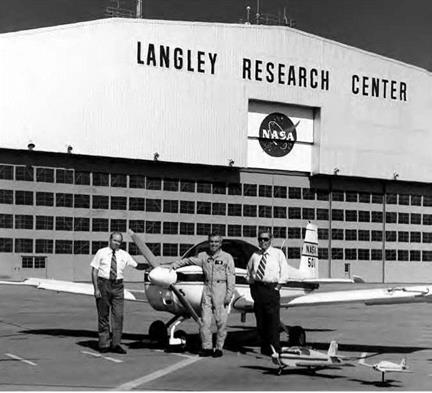General-Aviation Spin Technology
The dramatic changes in aircraft configurations after World War II required almost complete commitment of the Spin Tunnel to development programs for the military, resulting in stagnation of any research for light personal-owner-type aircraft. In subsequent years, designers had to rely on the database and design guidelines that had been developed based on experiences during the war. Unfortunately, stall/spin accidents in the early 1970s in the general aviation community increased at an alarming rate. Even more troublesome, on several occasions aircraft that had been designed according to the NACA tail-damping power factor criterion had exhibited unsatisfactory recovery characteristics, and the introduction of features such as advanced general aviation airfoils resulted in concern over the technical adequacy and state of the database for general aviation configurations.
Finally, in the early 1970s, the pressure of new military aircraft development programs eased, permitting NASA to embark on new studies related to spin technology for general aviation aircraft. A NASA General Aviation Spin Research program was initiated at Langley that focused on the use of radio-control and spin tunnel models to assess the impact of design features on spin and recovery characteristics, and to develop testing techniques that could be used by the industry. The program also included the acquisition of several full-scale aircraft that were modified for spin tests to produce data for correlation with model results.[515]
One of the key objectives of the program was to evaluate the impact of tail geometry on spin characteristics. The approach taken was to design alternate tail configurations so as to produce variability in the TDPF parameter by changing the vertical and horizontal locations of the
|
Involved in a study of spinning characteristics of general-aviation configurations in the 1970s were Langley test pilot Jim Patton, center, and researchers Jim Bowman, left, and Todd Burk. NASA. |
horizontal tail. A spin tunnel model of a representative low wing configuration was constructed with four interchangeable tails, and results for the individual tail configurations were compared with predictions based on the tail design criteria. The range of tails tested included conventional cruciform-tail configurations, low horizontal tail locations, and a T-tail configuration.
As expected, results of the spin tunnel testing indicated that tail configuration had a large influence on spin and recovery characteristics, but many other geometric features also influenced the characteristics, including fuselage cross-sectional shape. In addition, seemingly small configuration features such as wing fillets at the wing trailing-edge juncture with the fuselage had large effects. Importantly, the existing TDPF criterion for light airplanes did not correctly predict the spin recovery characteristics of models for some conditions, especially for those in which ailerons were deflected. NASA’s report to the industry following
the tests stressed that, based on these results, TDPF should not be used to predict spin recovery characteristics. However, the recommendation did provide a recommended "best practice” approach to overall design of the tail of the airplane for spin behavior.[516]
As part of its General Aviation Spin Research program, NASA continued to provide information on the design of emergency spin recovery parachute systems.[517] Parachute diameters and riser line lengths were sized based on free-spinning model results for high and low wing configurations and a variety of tail configurations. Additionally, guidelines for the design and implementation of the mechanical systems required for parachute deployment (such as mechanical jaws and pyrotechnic deployment) and release of the parachute were documented.
NASA also encouraged industry to use its spin tunnel facility on a fee-paying basis. Several industry teams proceeded to use the opportunity to conduct proprietary tests for configurations in the tunnel. For example, the Beech Aircraft Corporation sponsored the first fee-paid test in the Langley Spin Tunnel for free-spinning model tests of its Model 77 "Skipper” trainer.[518] In such proprietary tests, the industry provided models and personnel for joint participation in the testing experience.











